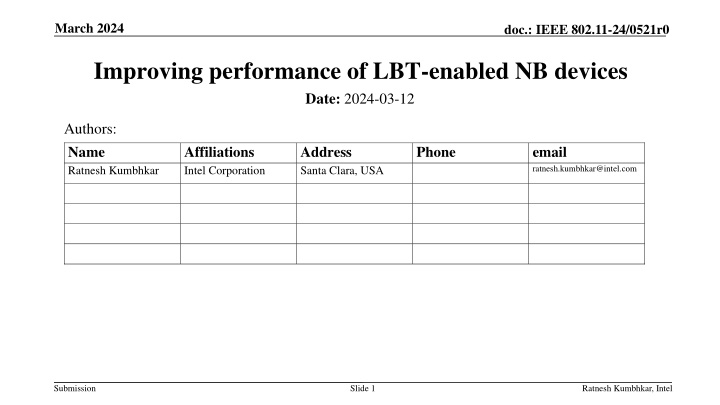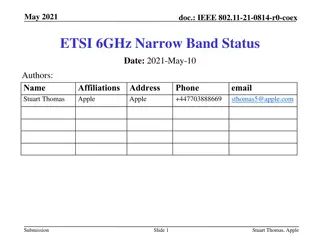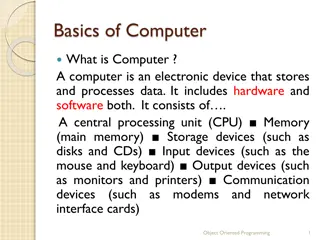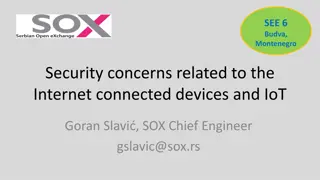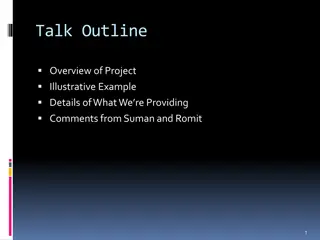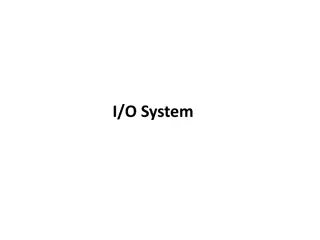Improving performance of LBT-enabled NB devices
This submission delves into optimizing the performance of narrowband signals like Bluetooth by utilizing Listen-Before-Talk (LBT) for channel access in the 5 and 6 GHz frequency bands. The study explores the potential advantages for Bluetooth devices in improving efficiency and reliability through LBT implementation alongside Wi-Fi channelization in these spectrum ranges.
Download Presentation

Please find below an Image/Link to download the presentation.
The content on the website is provided AS IS for your information and personal use only. It may not be sold, licensed, or shared on other websites without obtaining consent from the author.If you encounter any issues during the download, it is possible that the publisher has removed the file from their server.
You are allowed to download the files provided on this website for personal or commercial use, subject to the condition that they are used lawfully. All files are the property of their respective owners.
The content on the website is provided AS IS for your information and personal use only. It may not be sold, licensed, or shared on other websites without obtaining consent from the author.
E N D
Presentation Transcript
March 2024 doc.: IEEE 802.11-24/0521r0 Improving performance of LBT-enabled NB devices Date: 2024-03-12 Authors: Name Ratnesh Kumbhkar Affiliations Intel Corporation Address Santa Clara, USA Phone email ratnesh.kumbhkar@intel.com Submission Slide 1 Ratnesh Kumbhkar, Intel
March 2024 doc.: IEEE 802.11-24/0521r0 Abstract This submission explores the potential for performance improvement for narrowband signals, such as Bluetooth, when using Listen-Before-Talk (LBT) as the channel access mechanism. Submission Slide 2 Ratnesh Kumbhkar, Intel
March 2024 doc.: IEEE 802.11-24/0521r0 Introduction Bluetooth is planning to enable operation in the 5 and 6GHz bands. [1] Listen-Before-Talk (LBT) has been suggested as a channel access mechanism for Bluetooth in these bands. [2][3] Wi-Fi channelization is typically well-defined within these spectrum bands. This established channelization offers Bluetooth devices a unique opportunity to improve their performance while using LBT. Submission Slide 3 Ratnesh Kumbhkar, Intel
March 2024 doc.: IEEE 802.11-24/0521r0 Channelization Uses both UNII-2c and UNII-3 Uses both UNII-3 and UNII-4 Wi-Fi channels completely within UNII-3 CH 149 to CH 165 CH 144 CH 169 45 46 47 48 49 50 51 52 53 54 55 56 57 58 59 60 61 62 1 2 3 4 5 6 7 8 9 10 UNII-3, 5725-5850 MHz 2MHz Submission Slide 4 Ratnesh Kumbhkar, Intel
March 2024 doc.: IEEE 802.11-24/0521r0 Simulation parameters Wi-Fi: Bluetooth: Tx power: 20 dBm at AP/STA Single stream One directional traffic Traffic load: 60% TXOP duration 5ms Bandwidth = 80MHz RTS CTS A-MPDU BA Transmission starts at time=3s LE 2M PHY Gaming audio: 2 earbuds 1 earbud contains mic 1 earbud has inertial measurement unit (IMU) sensor Tx power: 14 dBm ISO interval = 7.5ms Max latency = 15ms (2 ISO) Number of subevents, NSE = 2 1 main TX + 3 retry opportunities Total 4 attempts If packet is not transmitted in 4 attempts, packet is flushed, and it results in a glitch Number of channels = 62 Total hopping BW = 124MHz Bi-directional traffic *Wi-Fi traffic load = 60% all further slides 20 MHz 80 MHz Wi-Fi3 Wi-Fi1 Wi-Fi2 Channel model: AWGN channel with a breakpoint at 5 m pathloss = 40.05 + 20log10(f/2.4) + 20log10(min(d, b)) + (d > b) * (35log10(d/b)) where d = distance, b = breakpoint = 5 m 5835 5735 5815 5850 5726 Bluetooth BW = 124 MHz Submission Slide 5 Ratnesh Kumbhkar, Intel
March 2024 doc.: IEEE 802.11-24/0521r0 Channelization Uses both UNII-2c and UNII-3 Uses both UNII-3 and UNII-4 Wi-Fi 2 Wi-Fi 1 and Wi-Fi 3 CH 144 CH 155, 80MHz CH 165, 20MHz CH 169 45 46 47 48 49 50 51 52 53 54 55 56 57 58 59 60 61 62 1 2 3 4 5 6 7 8 9 10 UNII-3, 5725-5850 MHz 2MHz Submission Slide 6 Ratnesh Kumbhkar, Intel
March 2024 doc.: IEEE 802.11-24/0521r0 Bluetooth LE transmission with LBT CCA 360 s 360 s 360 s 360 s Central P-1 172 s 172 s P-2 360 s 360 s Retrying transmission f1 f2 f3 f4 Idle period 3.946ms Connection interval = 7.5ms NSE = 2, Number of subevents in a connection interval FT = 2, Flush timeout: Number of connection interval after which packet is discarded Total 4 attempts to send the packet Submission Slide 7 Ratnesh Kumbhkar, Intel
March 2024 doc.: IEEE 802.11-24/0521r0 LBT with uniform frequency hopping Baseline performance for Wi-Fi 2 without any interference Wi-Fi transmissions start at 3s mark Impact of Bluetooth interference Latency for Wi-Fi 2 increases. No significant impact on Wi-Fi 1 and Wi-Fi 3. The latency seen in the figure is due to mutual deferral. Significant number of glitches observed in Bluetooth audio due to transmission deferral to Wi-Fi. Submission Slide 8 Ratnesh Kumbhkar, Intel
March 2024 doc.: IEEE 802.11-24/0521r0 Prioritization of non-overlapping channel In the final attempt to send the packet, the device hops to one of the non-overlapping channels (i.e., channels 1-5 and 56-62). Why not prioritize these channels from the first attempt? These channels become congested very quickly by the BT devices. Not scalable. Keeps the opportunity open for the overlapped channels to be used. Submission Slide 9 Ratnesh Kumbhkar, Intel
March 2024 doc.: IEEE 802.11-24/0521r0 LBT with channel prioritization Wi-Fi latency results remain almost same with and without channel prioritization. Suffix -pri indicates use of prioritized channel by Bluetooth. Bluetooth glitches can be significantly reduced with minimal impact on Wi-Fi latency compared to regular LBT. Submission Slide 10 Ratnesh Kumbhkar, Intel
March 2024 doc.: IEEE 802.11-24/0521r0 UNII-5 in FCC In the FCC regulatory domain, the 5925 MHz to 5945 MHz spectrum, which is not utilized by Wi-Fi in the UNII-5, could potentially be available for Bluetooth use. By applying the insights gained from our simulations, it could be beneficial to implement a similar channel prioritization strategy in the UNII-5 band as well. Submission Slide 11 Ratnesh Kumbhkar, Intel
March 2024 doc.: IEEE 802.11-24/0521r0 Summary By giving priority to any non-overlapping channels that may be available in the UNII-3 band (or UNII-5 in FCC) during the final attempts of a Bluetooth packet transmission, the number of glitches can be significantly minimized without causing any significant impact on Wi-Fi latency compared to regular LBT. Submission Slide 12 Ratnesh Kumbhkar, Intel
March 2024 doc.: IEEE 802.11-24/0521r0 References 1. 2. 3. https://www.bluetooth.com/specifications/specifications-in-development/ 11-24-0007-00-coex-proposal-for-bluetooth-and-wi-fi-coexistence-in-5-and-6ghz 11-24-0122-00-coex-bluetooth-isochronous-audio-with-lbt Submission Slide 13 Ratnesh Kumbhkar, Intel
March 2024 doc.: IEEE 802.11-24/0521r0 BACKUP Submission Slide 14 Ratnesh Kumbhkar, Intel
March 2024 doc.: IEEE 802.11-24/0521r0 Baseline Wi-Fi performance Submission Slide 15 Ratnesh Kumbhkar, Intel
